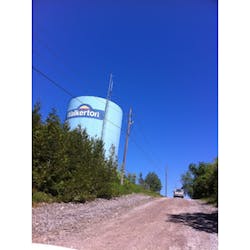Stopping Standpipe Stratification
Thermal stratification is often an invisible problem inside water storage tanks. Without taking water temperature measurements at different depths, a municipality may be unaware that warm water is trapped and aging for days or even weeks in the top
of their tank. Typically, the only warning signs of thermal stratification are sudden changes in disinfectant residual levels and taste and odor complaints, usually during warm summer months.
The Municipality of Brockton operates three water systems in Ontario, Canada, including the system at Walkerton, Ontario. Even without taking water temperature measurements, Utility Manager Colin Saunders was certain that the 70-ft-tall standpipe on the north end of its Walkerton water system had strong and persistent thermal stratification during summer months.
“Every morning on my drive to work, I would pass by the tank and see a band of condensation that did not correspond to the water level inside the tank,” said Saunders. “I knew this had to be caused by a layer of warm water that did not mix with the rest of the tank.”
Saunders and his team knew that temperature conditions inside their two standpipes could get extreme during summer months.
“When we would climb to the top of the tank and open the hatch, we would be hit with a blast of hot air that was easily over 100°F,” he said. “I was drenched in sweat after only a few minutes.”
Because standpipes are tall and narrow, they are especially prone to thermal stratification; water temperatures at the top of a standpipe in summer can be significantly hotter than the water at the bottom of the tank. With a second standpipe that was even taller at the south end of town, Saunders and his team realized that, for a few months out of the year, thermal stratification might be a systemic problem.
Saunders and his team also noticed that taste and odor complaints, while infrequent, would increase during summer months, typically when the thermal stratification problem was the worst. They suspected the two problems were related.
The solution
To research the issue and find potential solutions, Saunders contacted the firm that handled maintenance and repair of their tanks, a well-established tank-building firm with a good reputation across North America. But that group was only aware of passive mixing systems, which involve expensive modifications to the inlet and outlet of the tank and only mix when the tank is filling.
Saunders’ team was concerned. Would a passive system work under all fill and drain conditions? If the tanks were filled mostly at night, would mixing take place when it was not needed? Their concern grew when the team received pricing for the system: over $65,000 for each tank.
Saunders then reached out to H2Flow, a water technology sales and service group that had worked with the Walkerton system for years. H2Flow introduced Saunders’ team to an active mixing technology—the PAX Water Mixer. Unlike passive mixing systems, which only mix during the tank fill cycle, the PAX Water Mixer operates constantly, ensuring that water-quality conditions are consistent and uniform at all levels inside the tank and that thermal stratification never takes place. Best of all, the PAX Water Mixer was less than half the cost of the passive mixing system.
Saunders and his team purchased one mixer and installed it in the north standpipe. They also installed temperature probes to verify that the mixer improved conditions inside the tank.
“Some salesman will tell you what you want to hear in order to sell a product,” said Saunders. “We wanted to take the data ourselves to verify the actual performance of the system.”
The results
After turning on the mixer, the operators at Walkerton watched as thermal stratification was eliminated from their standpipe in only a few days.
“It was quite amazing to see the stratification disappear,” said Saunders. “You could really see the difference.”
The team also took infrared images of the north standpipe and compared them to images of the unmixed south standpipe in Walkerton. Whereas the north standpipe showed uniform temperatures from bottom to top, the south standpipe showed a clear band of warm water trapped in the upper part of the tank.
Convinced that they had found their solution, Saunders’ team installed a second mixer in the south standpipe. Since that time, they have seen more stable and consistent residual levels in the distribution system.
“We have received no complaints this last summer due to taste and odor,” said Saunders. “I am quite pleased with the simplicity of the system. Our operators can see that the mixer is on and running on our SCADA system.”
